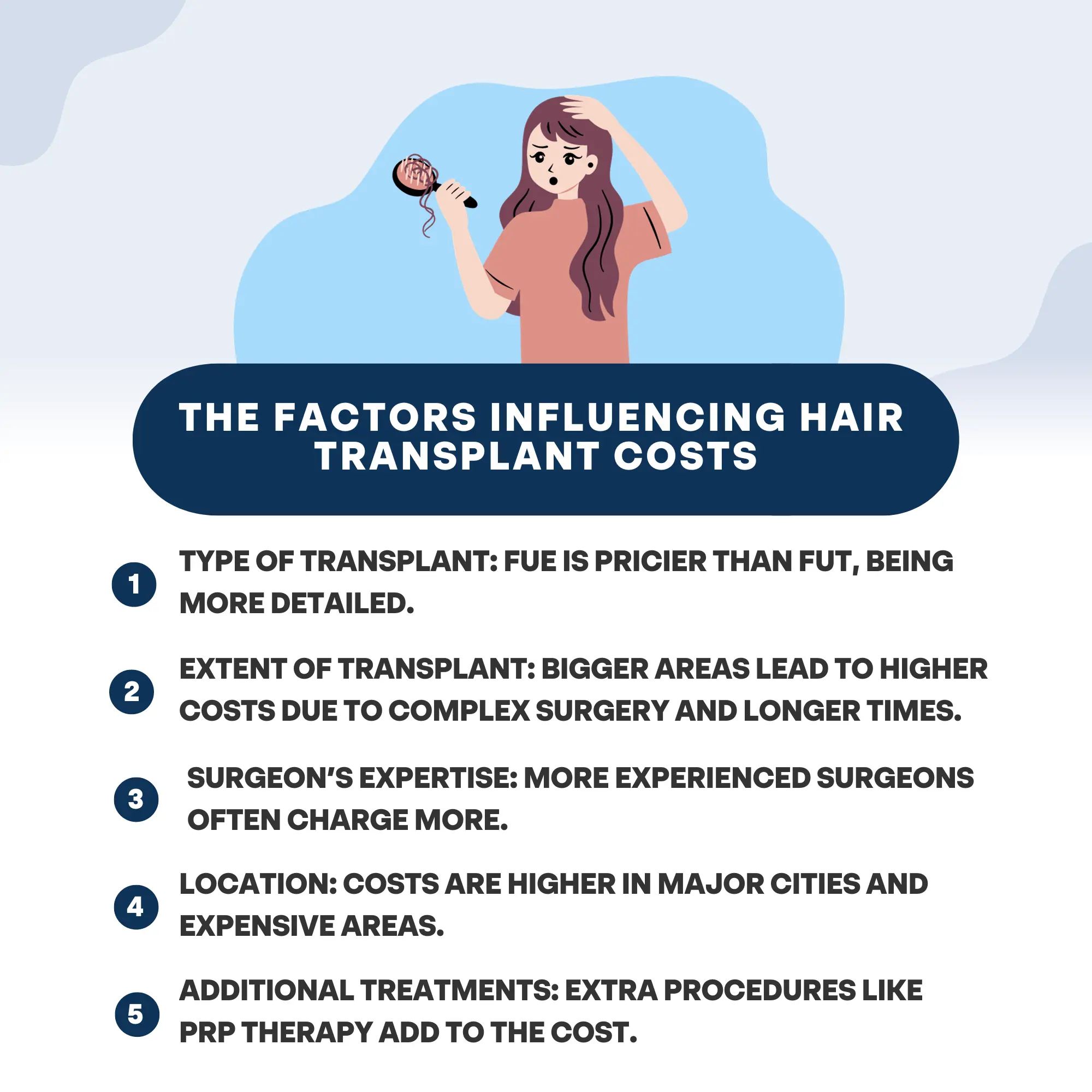Are you considering a hair transplant but worried about the expenses? It’s natural to be curious about the cost of such a procedure. After all, you cannot proceed with a hair transplant if you cannot afford the cost. While providing an exact figure is challenging, we’ll break down everything you need to know about hair transplant costs in this guide.
What is a hair transplant?
A hair transplant is a surgical procedure that involves removing hair follicles from one part of the body (donor site) and implanting them in an area where hair is thinning or bald (recipient site). The transplanted hair typically grows naturally, allowing you to restore your hairline, cover bald spots, or achieve the desired hair thickness.
Since a hair transplant is a personalized procedure, the cost can vary from person to person. Several factors influence hair transplant costs, and understanding them can help you anticipate the expenses involved.
What are the factors influencing hair transplant costs?
1. Type of hair transplant
Follicular unit extraction (FUE) and follicular unit transplantation (FUT) are the primary forms of hair transplants. FUE involves individually extracting hair follicles, while FUT involves removing a strip of scalp. FUE is typically more expensive because it is a meticulous process. FUT is less costly due to the simplicity of the procedure.
2. Extent of the transplant
The cost of a hair transplant is significantly influenced by the size of the treatment area. A larger area in need of hair restoration requires a more extensive surgical procedure, consuming additional time and effort from the surgical team. This complexity results in higher overall costs, as more hair follicles need to be extracted and transplanted, leading to increased surgical time, specialized equipment usage, and the need for skilled professionals.
Moreover, post-operative care and potential multiple sessions may further contribute to expenses. Therefore, the size of the area to be covered plays a pivotal role in determining the final cost of a hair transplant.
3. Skills and reputation of the surgeon
Highly skilled and experienced surgeons often charge higher fees for their services. The cost of a hair transplant may increase if you choose a surgeon with a successful track record and a reputation for delivering exceptional results.
4. Location
The geographic location of the hair transplant clinic can also affect the cost of the procedure. Hair transplant tends to be more expensive in major cities and regions with a high cost of living.
5. Additional treatments
In some cases, additional treatments like PRP (platelet-rich plasma) therapy may be recommended to enhance the hair transplant results. These supplementary procedures can increase the overall cost of the hair transplant.

How much does a hair transplant cost?
Depending on the above-mentioned factors, hair transplant costs can range from a few thousand dollars to as much as $15,000. On average, a hair transplant costs between $4,000 and $8,000.
How much does a hair transplant cost: FUE vs. FUT?
Hair transplant costs can vary depending on the type of procedure you choose. FUE, being a more complex and time-consuming process, is generally more expensive than FUT. On average, FUE can cost between $5,000 and $15,000, while FUT can range from $3,000 to $10,000.
Does insurance cover hair transplant costs?
Hair transplant costs are usually considered elective procedures, so insurance doesn’t cover them. However, some insurance plans may offer coverage if the hair loss is caused by an accident, disease, or medical condition. It’s best to check with your insurance provider to determine the extent of your coverage.
What are the financing options for hair transplant costs?
If you’re concerned about the upfront cost of a hair transplant, several financing options can help you manage the expense:
- Medical credit cards: These are specifically designed for medical expenses and often offer promotional financing options like interest-free periods.
- Personal loans: You can consider taking a personal loan to cover the hair transplant cost. It’s advisable to shop around for the best interest rates and terms.
- Crowdfunding: Individuals have sometimes successfully raised funds for their hair transplant costs through crowdfunding platforms by sharing their stories and treatment goals.
- Savings: If you have been saving for a particular purpose, you can allocate funds from your savings for your hair transplant.
It’s important to note that while financing can make hair transplant costs more manageable, you should carefully consider the repayment terms and any associated interest to avoid financial strain.
Key Takeaway
When considering a hair transplant, it’s crucial to clearly understand the potential costs involved. While the price is essential, it should not be the sole consideration in choosing a hair transplant clinic. The quality of care, the surgeon’s expertise, and the likelihood of achieving the desired results are equally vital.
Looking for a trustworthy Florida hair transplant clinic?
For a trustworthy Florida hair transplant clinic, choose Pizarro Hair Restoration. Our experienced team is dedicated to helping you regain your hair and confidence. Contact us today to schedule a personalized assessment for your hair transplant needs. Your journey to hair restoration starts here!






